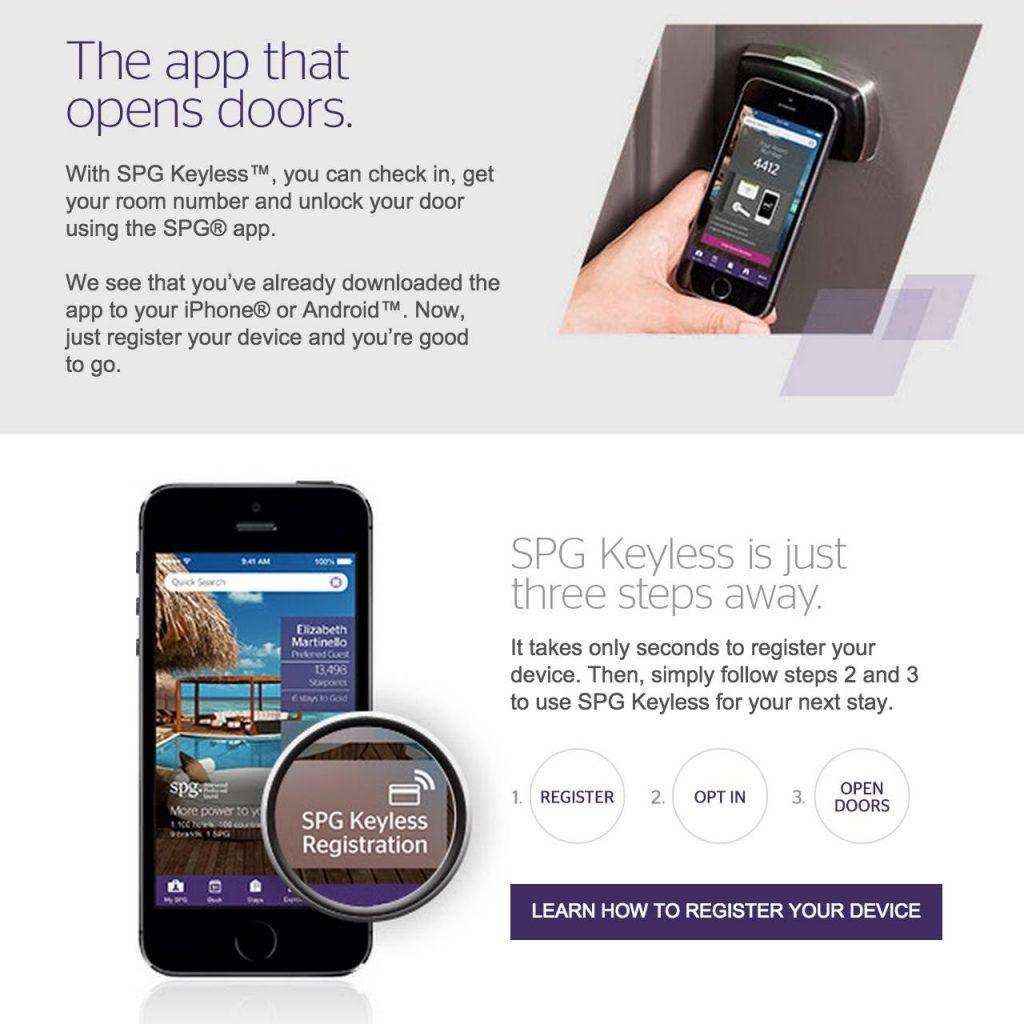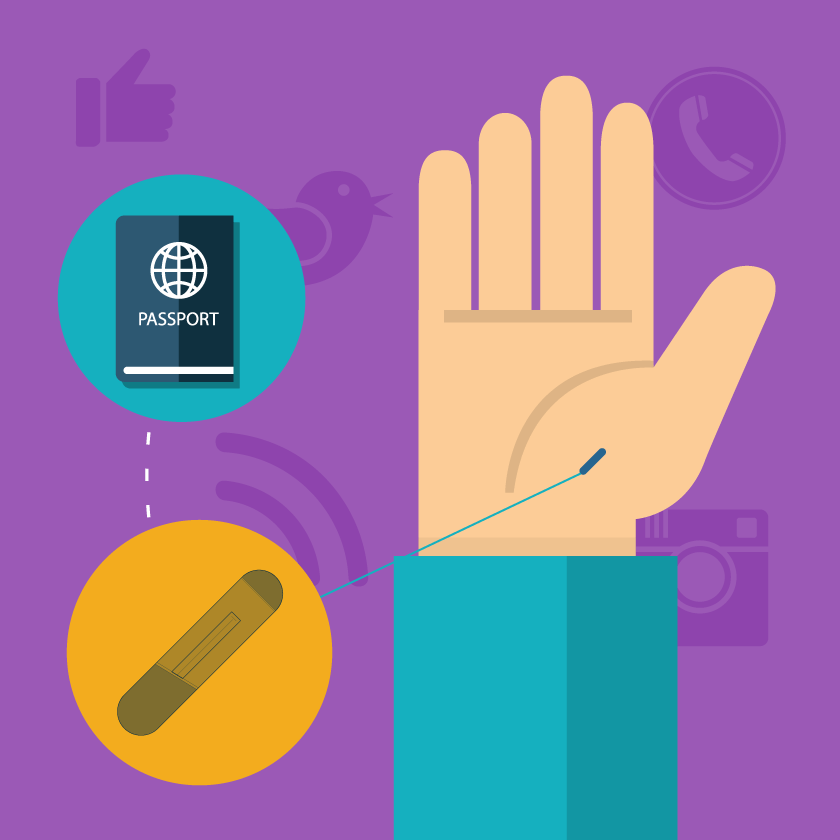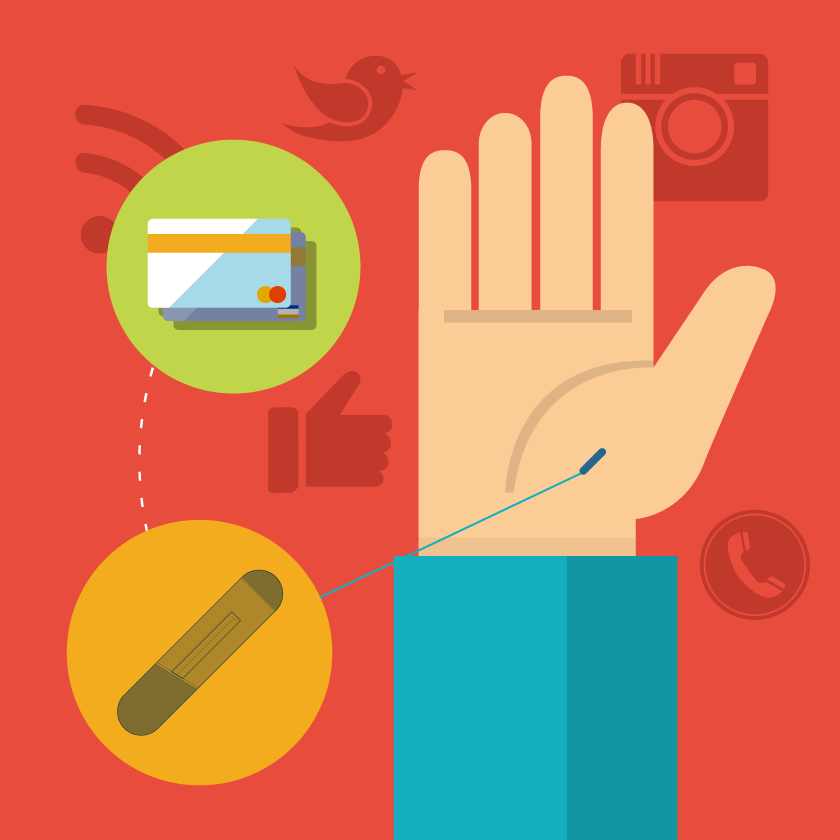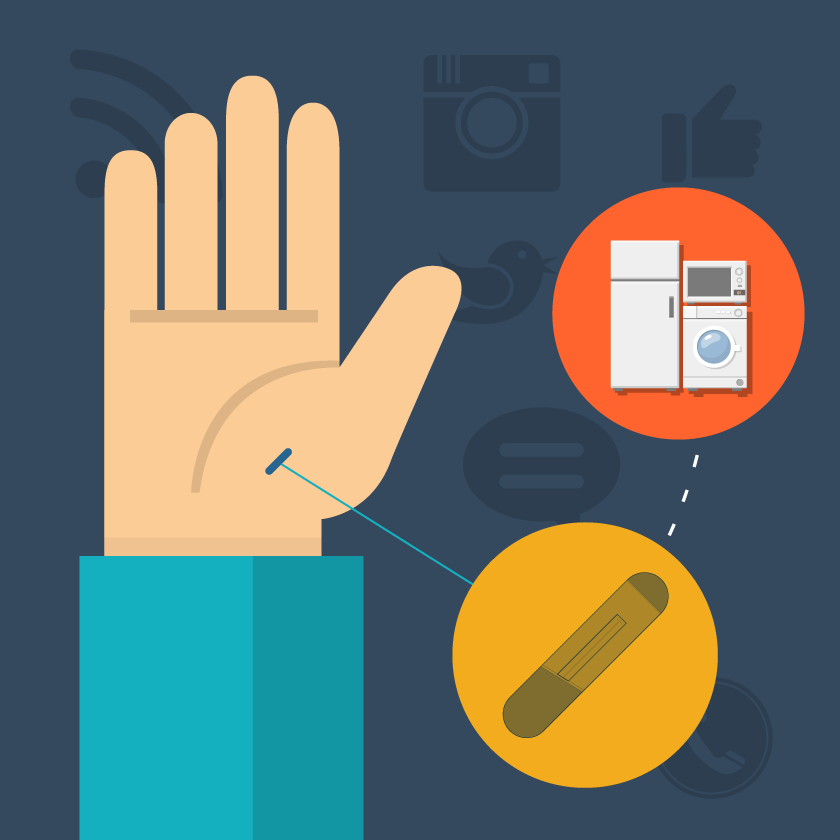From the moment of the biochip injection I was repeatedly asked the same, almost Shakespearean, questions: “Once I decide to become a cyborg, how will my current routine change? What’s the point in modernizing myself?”
Today, I would readily answer it in 1,001 different ways, and the number of use cases I was able to explore continues to grow exponentially day by day. Let me share some of the most realistic and feasible ones with you.
01. Opening any lock by touch
A couple of years ago, I spoke at one of those backstage events for IT engineers, where I, absolutely seriously, talked about the possibility of completely getting rid of door keys.
In order to heat up the discussion, I bet a bottle of cognac (know your audience, hah!) on the odds of the HORECA industry being the first to bid farewell to this rudimentary security technique: I vouched for hotels, in particular, to be able to generate unique temporary electronic keys on the client’s smartphone during the process of reserving the accommodation through online services like Booking.com.
Upon paying for the accommodation, a client armed with a Bluetooth/NFC-enabled smartphone would be able to open the door just by standing in front of it. The reception, which currently acts as an intermediary in this process, would then be phased out, thus optimizing infrastructure costs for hoteliers.
I don’t even talk about the benefits of this approach for AirBnB users who, generally, claim passing the key is one of the most annoying aspects of the process.
A part of the audience laughed at my speech, calling it bull crap. Another part, having hopes of a bottle of cognac, admitted this scenario is meant for a relatively distant future (20 or 30 years from now). There was one more group among the audience who took it all seriously. In fact, I recently received a message from the Starwood Hotels customer service:
So, now I can claim that the following happened: I, the planet’s first ever professional cyborg, sent myself into the past this morning, in order to save John Connor, the would-be leader of an anti-machine resistance, and stop the Apocalypse predict today to a group of developers. This future is the one where, with a biochip in your hand, the need for any ‘real’, ‘hardware’ key to any lock is no more. A biochip can obtain and keep admission rights to any lock, whether it’s the one for a hotel room, a house, a garage, or a car.
02. Driver license and passport replacement
Essentially, what is a driver’s license? It is a very damage-prone piece of plastic with an owner’s photo adorned by holograms, as well as his/her first/last name, date of birth, unique number, and checked vehicle categories.
The State Road Safety Inspection has long abandoned their hopes of the impossibility to fake beacons, “flags”, licenses and badges (no hologram would protect from that, really). That’s why, once a vehicle is pulled over by the police, an officer checks the driver’s license and a vehicle certificate against their database to find out whether the piece of plastic is legitimate (and whether the bearer is a good guy).
How would the entire procedure look with a biochip in play? The officer presents the reader through the windshield, I touch it with my hand – and that’s it. The officer does not need the piece of plastic; he operates the information: He uses the number of the license to search the respective entry in the database, and then sees whether the photo matches my face. What element contains this identity information, whether a piece of plastic in the wallet or a piece of silicon under the skin, would not matter to him.
Moreover, the chip has certain advantages in this respect. For example, the information contained by the chip is encrypted and available only to an official who has a state-issued mandate to read and decrypt driver’s data when on duty; this mandate would immediately become invalid as soon as the officer’s shift ends.
03. Universal discount card
I have a friend, who’s an outright shopaholic (anyone who has such a friend knows that in the majority of cases her name is Julia). Her wallet has been unable to contain all of her discount cards, so she has to carry around an additional discount-card-only wallet, kind of like Colonel Colt’s revolver.
Companies value loyal customers, so they put a lot of effort into deploying various loyalty programs: users who are heavy shoppers get a ‘thank you’ enhanced with corresponding valuables in return for any purchase. There is a problem, though: There are many shops and just one customer to shop them all.
Why would you continue to grow the number of these otherwise useless pieces of plastic? The very concept of a discount program is based on the unique client ID. The rest is conveniently stored in a database on a server.
If you use a biochip to store your credentials, the scenario would look a lot simpler: Once you touch the reader with a hand, you get a discount, as the register would instantly recognize you in the loyalty program database.
04. E-Wallet tethered to bank cards
Well, since I am enabled to touch readers with my biochip-injected hand, why not pay with it instantly? Using NFC for payment is already a reality.
If everything works fine, in one of my #BionicManDiary vlogs planned for the upcoming months, I will be able to demonstrate the ability to pay with a biochip in Starbucks. If I succeed, I will try to perform all my daily financial operations with help of the biochip.
05. Patient record + insurance certificate
Contrary to their advertised promises, insurance companies are not willing to pay money for nothing. The insurance business is a product of the sophisticated probability calculus which is based on the insurer’s access to the fullest record of the insured’s health and modus vivendi, which is then used to identify the terms of the contract.
That’s exactly why even in cases of mortgage programs the insurance company requires an applicant to have a full-fledged medical examination in order to avoid initially unprofitable insurance certificates. You know what I mean. Unfortunately, medical databases are different for all medical institutions, patient records are frequently lost even in commercial healthcare organizations, and the full patient record is, in most cases, unheard of.
#BionicManDiary, entry 001: the story of how a chip was implanted into my body: https://t.co/tEawdUC2tj by @cheresh pic.twitter.com/dXwzYUdYSC
— Kaspersky (@kaspersky) February 26, 2015
This is something which is not beneficial for anyone, whether an insurer, a doctor, or a customer. A chip might serve as permanent storage for full and detailed patient record, including information on minor diseases; all purchased, prescribed, or taken meds; vaccinations; and test procedures (like blood tests, X-ray, MRI) combined with the respective test results.This will help to substantially decrease the number of erroneous diagnosis cases when a patient is examined by a new doctor; secondly, it will immensely cut the costs of insurance and of medical services themselves: many of the repetitive tests would not be necessary. The process of getting an insurance certificate would just be limited to touching a reader with your hand.
06. oAuth for any online service (log-in via biochip)
The very essence of a password is an unhuman thing: a regularly changed set of numbers and symbols is a very convenient solution for a computer: it ‘thinks’ these symbols, after all. For a human, the task of regularly creating a new, unique, sophisticated password for each service is practically unbearable.
Many large enterprises are seeking ways to solve the ‘password problem’: they try to eliminate it as such or, at least, make the entire log-in process easier for people. It is highly likely that you have been using the ‘Log-in via Facebook/Twitter/etc’ capabilities for quite some time. It is a convenient approach, after all.
#Twitter plans to replace usernames with mobile phone numbers & #passwords w/ one-time, SMS-generated codes http://t.co/eF2ihLiWGQ
— Kaspersky (@kaspersky) October 25, 2014
But as soon as I have turned into a #BionicMan, I realized that there are things I become increasingly less tolerant towards. For example, I am not eager to share information on apps and services I use, as well as who I interact with and how frequently.In the Internet of Things era the proliferation of such authorization capabilities effectively urges me to let Facebook, Twitter, and Google into my smart home/car, or my private life. The task of constantly creating and changing safe passwords for connected fridges, TVs, coffee machines and other appliances is the Sythyphus labor and no one in their right mind would be inclined to do this voluntarily.
It bugs me that I really get what interest Facebook/Twitter/Google/Yandex have in my data, whereas for me this need seems a tad controversial. Curiously, all those companies really believe that the convenience of the authorization process justifies the unlimited access to my private data.
But this is not the case; I (and I am sure many ‘connected’ people would stand for this cause) would rather prefer to use ‘Log in via biochip” capability and guard all the information on which service and when I logged in in my personal encrypted storage. Or, better yet, to ultimately skip this step in the authorization process and log in to the system, email, and other apps directly with a simple touch.
07. Internet of Things and Smart Home setup
Imagine your entire household is connected, including locks, lighting, faucets, radiators, a coffee machine, a microwave, your cat’s collar, etc.
Now imagine you live with a family of 3-5 people. Everyone has their preferences towards the way your smart home functions: to how bright the lights are, to the indoor temperature, to the sort of coffee, or to the brand and sort of water to purchase via your smart fridge.
In order to make life in a smart home a pleasant experience, your home should always watch you and adapt to your needs. Once, say, John enters the room, the lights turn on, and a Guns ‘n Roses album is played on iTunes. Once he goes to the hall, the music is now played through the speakers in the hall, whereas in the room he was before everything turns off for the sake of saving on utility bills.
Jane, under the same circumstances, will enjoy a comfy twilight atmosphere and listen to The Moonlight Sonata via Google Play, as she uses the Android ecosystem.
With a biochip in play, this scenario is real. A person would not be forced to think of how to tame IoT, s/he just lives a life, while his/her smart home ‘sees’ his/her biochip, studies movements and touches, and learns to live with its master. And, consequently, makes the owner’s life much more enjoyable.
08. Universal ticket to anywhere
Many ask for paper air or train tickets and public transportation card. A person with a biochip would not need them all.
The principle in this case is the same as that of the discount card I mentioned above. From the machine’s perspective, a ticket is just a unique set of symbols which corresponds to a permission issued to a person to travel. Whether a ride on any kind of transportation, Hans Giger’s exhibition, or a U2 gig, a ticket can be paid for or presented at the terminal via a biochip.
#BionicManDiary: 10 ways to use #biochip in everyday life
09. Anti-theft protection for smartphones, laptops, or other devices
One of the most realistic use cases for a biochip is its use as an additional authentication factor to existing means of security.
In real life it would look as follows: you have a smartphone protected by a password which, when entered, unblocks the phone. If your device was stolen, a culprit might be able to guess the password, or even know it from the start, and then access your critical data.
Don't forget to check your password! #PassChecker http://t.co/vXnwmfqSWh https://t.co/P9Pm0SGc4n
— Kaspersky (@kaspersky) October 22, 2014
But if you activated biochip-enabled protection, a smartphone would not start in someone’s hands. So, even in the case of a thief knowing your password, he won’t be able to access the info.
10. Commanding a personal robot army
Believe it or not, a 9-year-old kid asked me (and he was damn serious): “When will you present me to your army of robots which you will use to conquer and rule the world and maintain peace of Earth?”
At first, I was a bit stunned, but then the kid turned out to be a huge Isaac Azimov’s fan (thank God this generation is not completely lost!), and we had a fascinating discussion, which made me think twice about his question.
Theoretically, a human exploring potential symbiosis between a living organism and a machine would be one of the first to assess many hidden aspects of this ‘partnership’ and learn to command the IoT while having, say, ‘elevated’ access privileges.
Should we be afraid of artificial intelligence? https://t.co/fPyaiSYrkk #ai #artificialintelligence
— Kaspersky (@kaspersky) June 12, 2015
There would be an inclination to use it for someone’s personal ambition. Whereas I do not dispute the good intentions I personally – or we at Kaspersky Lab – have, I wouldn’t be so sure about cybercriminals.
Many other questions arise: what is the bionic man of the not-too-distant-future? Does he have to follow three laws of robotics along with common legal and moral code of conduct? Does he count electric sheep when going to bed?
Let’s mull this over – I would be grateful for your comment and questions.
#BionicManDiary Entry 001 — The story of how a chip was implanted into my body
#BionicManDiary Entry 002 — The one where the chip started to toss and turn at night
#BionicManDiary Entry 003 — The one where I bypassed the smartphone’s password
#BionicManDiary Entry 004 — The one in which Star Wars turned to be much closer than in the galaxy far, far away
 biochip
biochip





 Tips
Tips